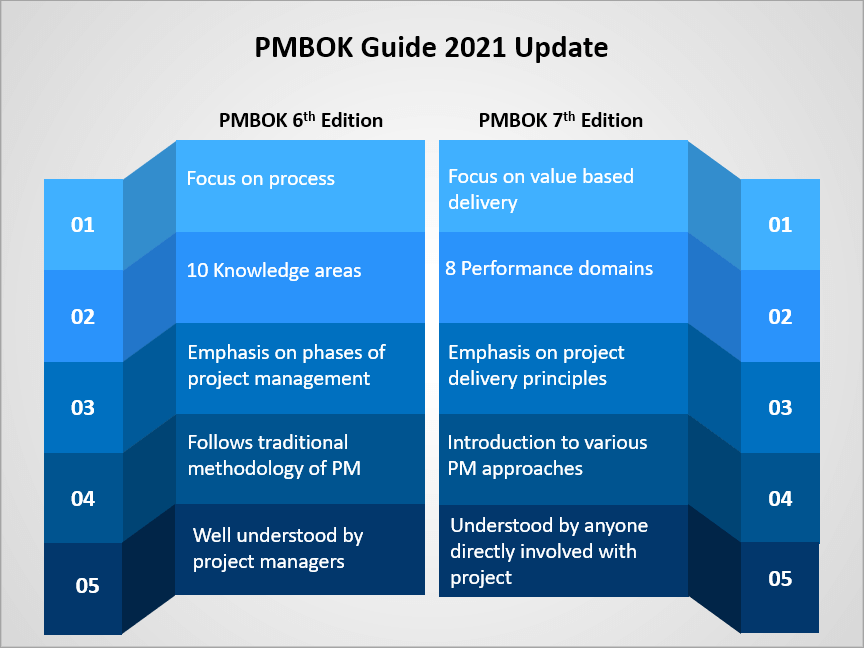The Project Management Body Of Knowledge (PMBOK) is a guide released by the Project Management Institute (PMI). The guide assists aspirants of PMP Certification with their preparation. The launch of the first PMBOK Guide was in 1994. Radical project management changes led to printing different PMBOK Guide versions. The latest guide for PMP candidates is the 7th edition of PMBOK, released in 2021.
Jump ahead to
Changes Seen in the 7th Edition of the PMBOK Guide
PMBOK guide is the foundation for individuals taking the PMP Exam. The 7th edition focuses on the system for value delivery initially released in the 6th edition. Seventh Edition of this guide shifted from being a process-oriented guide to one that was focused on principles. PMBOK is regularly updated by PMI to take into account changes and advancements in the project management industry. The goal of these revisions is to keep the PMBOK guide current and in compliance with the standards and best practices in project management.

Summary of changes:
- The process groups under the title of “The Standard for Project Management” are replaced with 12 principles of PM.
- Under the title of “A Guide to the Project Management Body of Knowledge,” the ten knowledge areas are replaced with 8 project performance domains.
- New section: Tailoring and Models, Methods, and Artifacts
How to acquire a PMBOK Guide?
PMBOK guide is available as a paperback and a digital copy. To access the free digital copy, an individual must be a member of PMI. The paperback is available in several bookstores and on Amazon.
What does the PMBOK Guide consist of?
Every PMP aspirant needs a thorough understanding of the following sections to clear the PMP Exam. These sections include Standard for Project Management and Guide to the Project Management Body of Knowledge.
Standard for Project Management covers three section introduction, System for value delivery and Project Management Principles. Also, Guide to the Project Management Body of Knowledge includes project performance domains, tailoring and models, methods, and artifacts.
Standard for Project Management
The standard to be followed, regardless of size, industry, location, and delivery methods, is described here. Stakeholders, project practitioners, and individuals accountable for the project’s progress refer to this standard for handling projects.
System for Value Delivery
This section defines how project managers can create value for organizations and stakeholders; a governance system to measure the value created; a list of operations for supporting the project; the influence of external and internal environments on the project, and the interconnection of projects, portfolios, programs, and products.
Project Management Principles
Project management principles focus on providing guidelines to project managers for managing people. Team members need to adhere to the following principles to ensure the desired results of the project delivery. They include:
Stewardship:
The goal of stewardship is to accomplish project goals while maintaining compliance, care, truthfulness, and integrity. Project stewards need to practice responsible management both inside and outside the organization. They should be diligent, considerate, and respectful to their team, suppliers, end users, customers, and other stakeholders. Additionally, they are accountable for the environment, society, and financial impacts of the project.
Team:
Members of project teams possess a variety of skills, expertise, and experiences. Project teams that collaborate may therefore achieve a common goal more quickly and effectively than those who work alone. Therefore, it is critical to foster an environment where everyone works toward the same end result. Roles and duties must be clearly defined, and the team must work together. Furthermore, a collaborative team environment promotes learning and growth for both an individual and team, alignment with other business cultures and policies, and the best possible contributions to the achievement of goals.
Stakeholders:
Stakeholders have a significant impact on the project outcome. Therefore, it is essential to proactively include stakeholders and to the extent required to support project success and customer satisfaction. Effective communication is necessary to engage a stakeholder efficiently. It also includes choosing communication strategies like “how,” “when,” and “how often”. Engaging stakeholders helps to avoid their potential negative, and increase positive impacts on the project.
Value:
The ultimate indicator of a project’s success is value. It can be accomplished at any point during the project, even after it is completed. Team members should define the purpose of the project and strive to meet a specific business requirement to add value to the project. Aligning stakeholders with the vision is necessary for the realization of value. Teams should be more concerned with the desired result than the deliverables. Furthermore, the value varies throughout various projects and businesses.
Holistic approach:
PMBOK 7 considers a project as a system made up of individuals, processes, technology, and other interconnected internal and external components. So, project managers need to handle the effects of shifting internal and external circumstances and adopt a holistic mindset. Furthermore, systems are dynamic, meaning that both internal and external factors need to be continuously monitored. Project teams should thus be attentive to system interactions so they may take advantage of favorable results.
Leadership:
Project success and favorable project results are enhanced by effective leadership. Professionals who aspire to be great leaders should foster an environment that is rich in inspiration, motivation, enthusiasm, empathy, and support. They should be aware of the variations in motivation among the members of the project team. Additionally, they should also exhibit the desired conduct in the areas of ethics, honesty, and integrity. Under this type of leadership, team members can work better and achieve the intended results.
Tailoring:
Every project is distinct from another. Therefore, the project team should use a “just enough” method to maximize value, manage cost, and enhance speed while designing the project development strategy, taking into account the project’s context, objectives, stakeholders, governance, and environment. Tailoring projects can increase a company’s ability for creativity, effectiveness, and productivity and to adjust to changing project conditions.
Quality:
Project managers should continue to prioritize quality to generate deliverables that satisfy project goals and comply with the needs, uses, and acceptance standards specified by relevant stakeholders. Ensuring that project processes are acceptable and as effective as feasible is part of project quality. Quality should taken into account at every stage of the project. Team can evaluate deliverable’s quality by auditing and inspection. Moreover, they can use reviews and audits to confirm the quality assurance process.
Complexity:
The quantity of risks, occurrences, circumstances, and stakeholders makes certain projects more complicated than others. Complexity is a characteristic of a project that can be impacted by system behavior, human behavior, or the ambiguity and unpredictability of technological advancement. Therefore, the project team should have adaptability skills and be open to adopting novel ideas to handle complexity. They need to recognize the components of complexity and apply a range of techniques to lessen its influence or amount.
Risk:
Every project has both opportunities and risks, which can be positive or negative. Therefore, project managers should continuously address risk during the project. They need to assess risk exposure, including threats and opportunities, to limit adverse impacts and maximize positive effects on the project results. They should be able to provide responses that are appropriate for the risk’s significance, economical, approved by the relevant stakeholders, and owned by a responsible person.
Adaptability and resilience:
Project managers should be able to adapt and respond to change if they want to enhance their projects. So project team should include adaptation and resilience in their methods to facilitate change, overcome challenges, and progress the project’s objectives. It should also involve both external and internal changes. Therefore, project managers and their teams should learn to adjust to the new changes.
Change Management:
There are two possible sources of change in a project: internal and external. It might be difficult to allow change in a project since it requires some flexibility and getting to know people both inside and outside the team. The project manager is responsible for making sure the right change management strategies are applied. They should include stakeholders and encourage them to embrace change to ensure success.
Guide to the Project Management Body of Knowledge
This part describes the link between the project management standard and the PMBOK guide.
Project Performance Domains
The domains mentioned here establish an integrated system for delivering projects with the desired outcomes.
- Stakeholder: PMP aspirants learn to perform stakeholder analysis to maintain a healthy relationship.
- Team: Activities related to managing people who produce results while initiating interpersonal skills come under this domain.
- Development approach and lifecycle: Tasks that assist in developing products or services following the project lifecycle are described under this element.
- Planning: This domain lists the plan for organizing and collaborating on activities necessary to deliver the results.
- Project work: Procedures, acquiring resources, and creating a learning environment for the project team come under this domain.
- Delivery: Tasks related to the delivery of scope and quality that the project intends to achieve on completion are listed here.
- Measurement: Evaluation and control measure tasks for maintaining a standard level of performance are described here.
- Uncertainty: Activities associated with risks and uncertainties arising from the project are listed under this element.
Tailoring
This part is the new section in the PMBOK guide. It assists project management professionals (PMP) in making changes in the procedures followed for project management. This, in turn, helps tailor PM practices per project and organization needs. Tailoring can be applied to different elements of project management, such as project lifecycle, processes, stakeholder relations, models, and artifacts. This benefits the organization and project managers in many ways.
Models, Methods, and Artifacts
PMP aspirants should master the commonly used methods, models, and artifacts for managing projects. It enables the project team to select the best tools from the many options available. This helps in setting strategies and achieving desired outcomes.
Conclusion
With the help of the PMBOK Guide, PMP aspirants gain a clear understanding of the latest practices, tools, and techniques. Professionals can effectively manage their project-related tasks with this knowledge. PMBOK Guide helps speed up acquiring the gold standard of Project Management Institute’s Project Management Professional (PMI-PMP) Certification. Aspirants can undergo PMP Certification Training course to gain knowledge of the changes mentioned in the exam outline. This helps individuals to gain a comprehensive understanding of 12 principles and eight domains. With the expertise of highly qualified trainers in project management, candidates can clear PMP exam easily.



